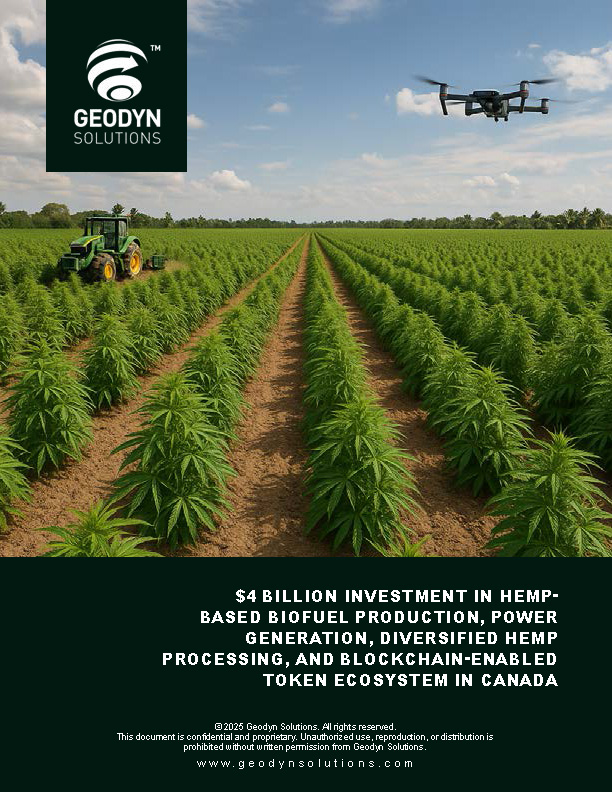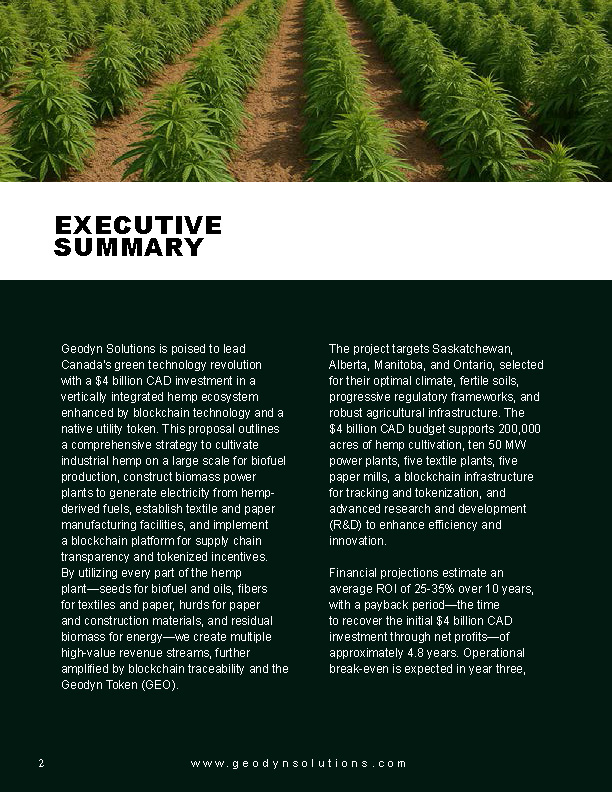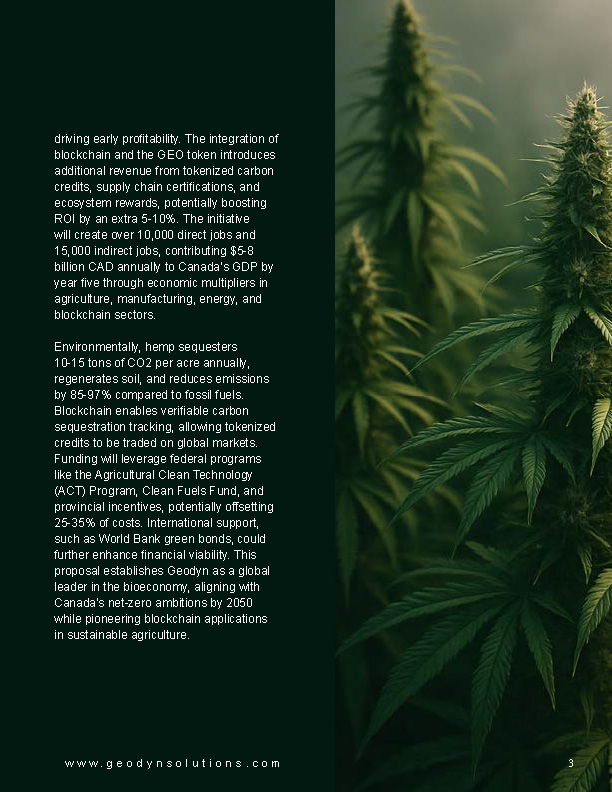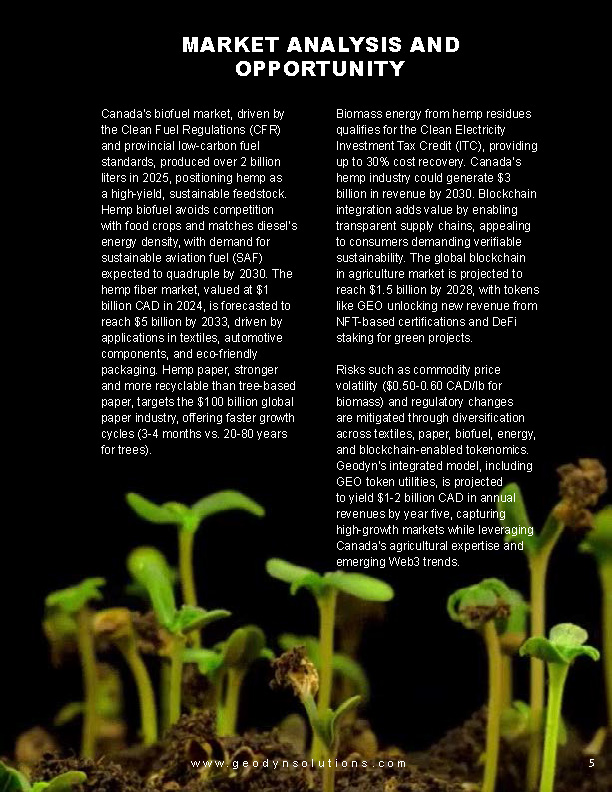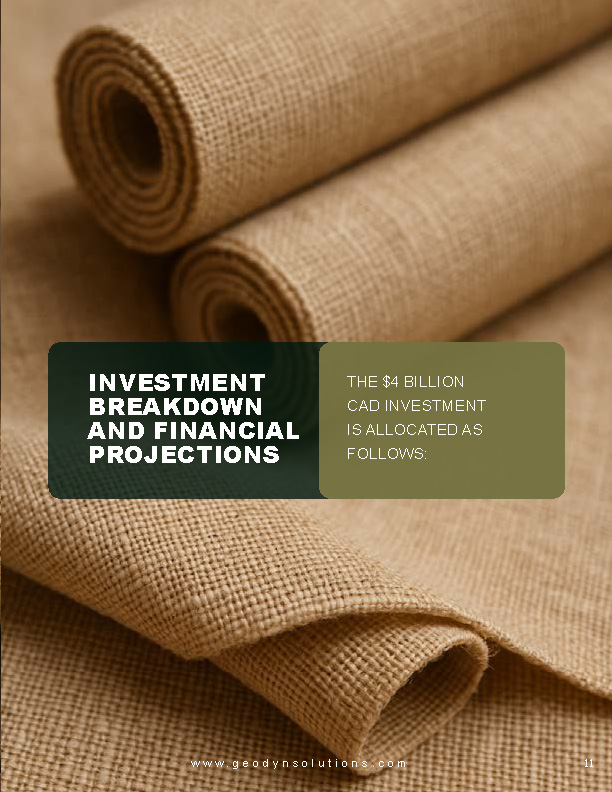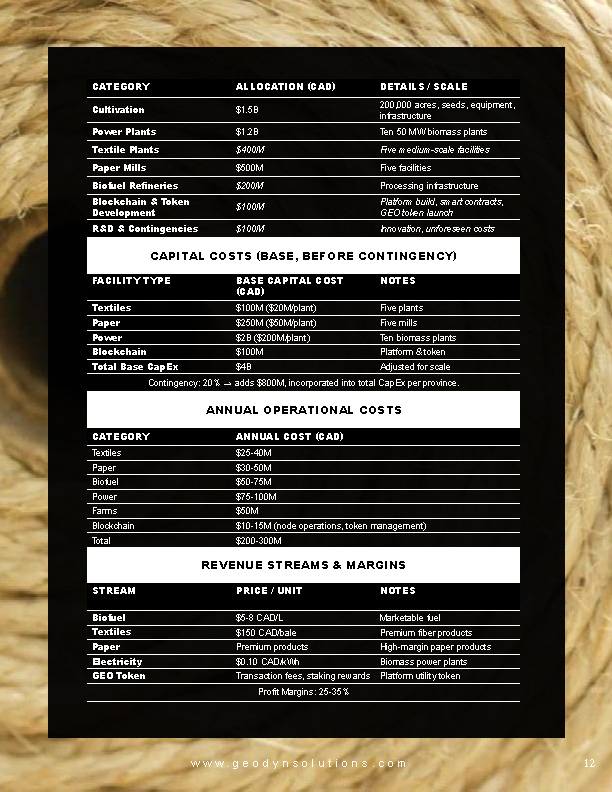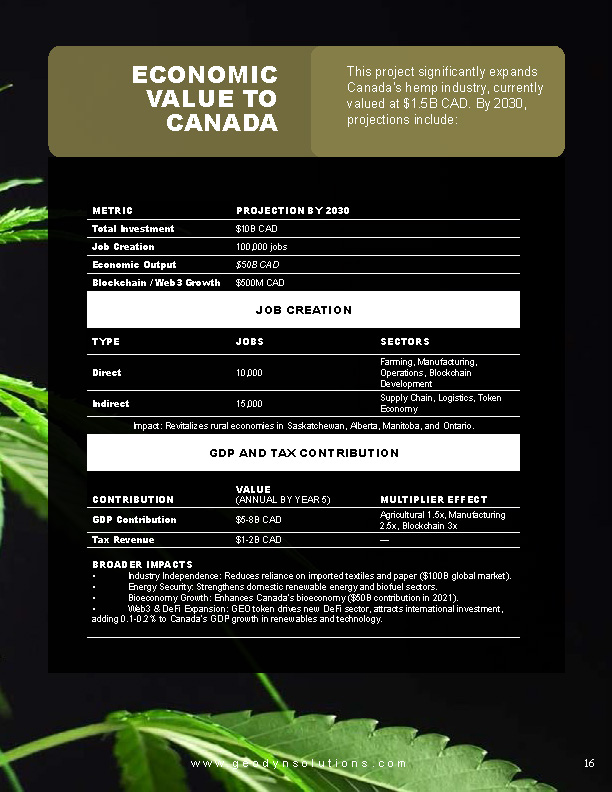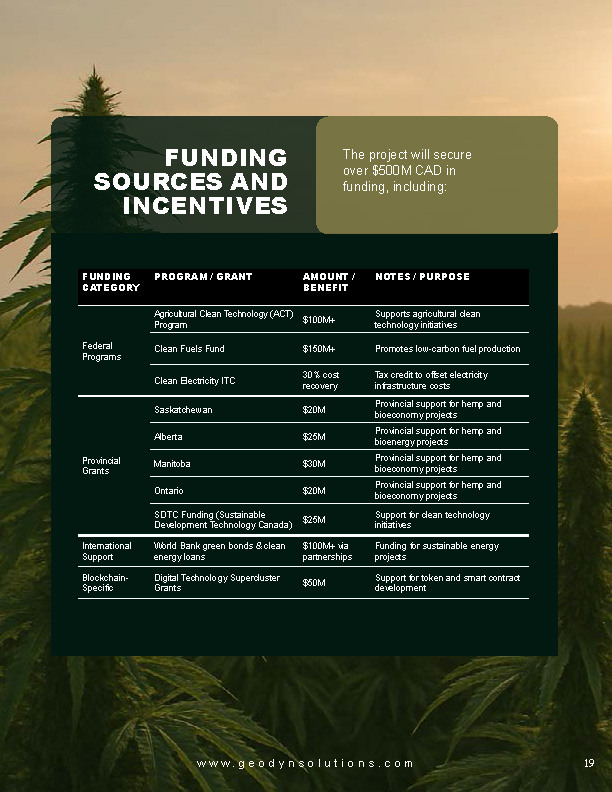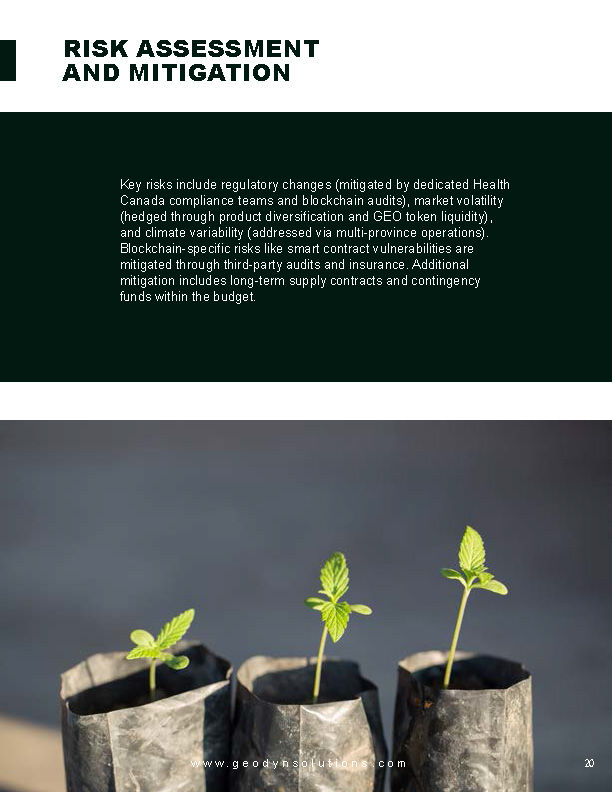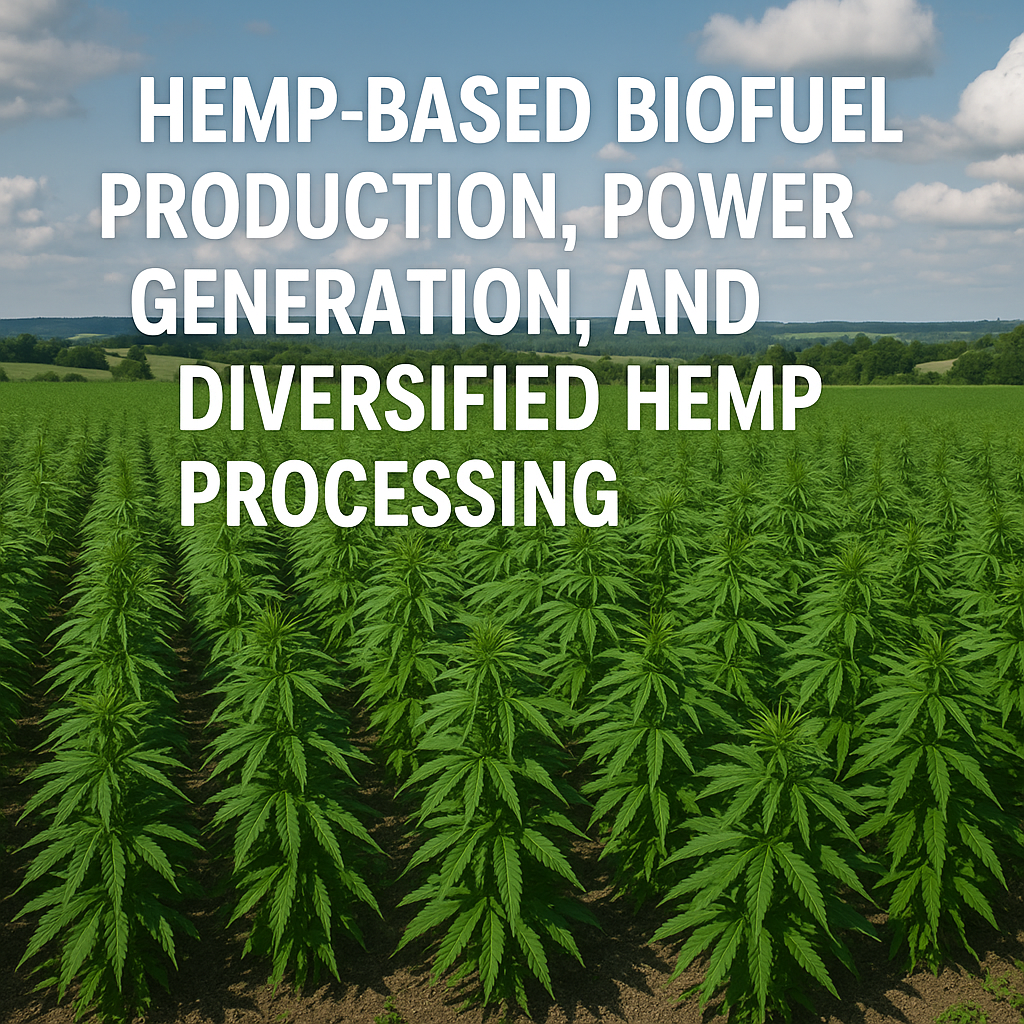$4 Billion Investment in Hemp-Based Biofuel Production, Power Generation, Diversified Hemp Processing, and Blockchain-Enabled Token Ecosystem in Canada
Executive Summary
Geodyn Solutions is poised to lead Canada’s green technology revolution with a $4 billion CAD investment in a vertically integrated hemp ecosystem enhanced by blockchain technology and a native utility token. This proposal outlines a comprehensive strategy to cultivate industrial hemp on a large scale for biofuel production, construct biomass power plants to generate electricity from hemp-derived fuels, establish textile and paper manufacturing facilities, and implement a blockchain platform for supply chain transparency and tokenized incentives. By utilizing every part of the hemp plant—seeds for biofuel and oils, fibers for textiles and paper, hurds for paper and construction materials, and residual biomass for energy—we create multiple high-value revenue streams, further amplified by blockchain traceability and the Geodyn Token (GEO).
The project targets Saskatchewan, Alberta, Manitoba, and Ontario, selected for their optimal climate, fertile soils, progressive regulatory frameworks, and robust agricultural infrastructure. The $4 billion CAD budget supports 200,000 acres of hemp cultivation, ten 50 MW power plants, five textile plants, five paper mills, a blockchain infrastructure for tracking and tokenization, and advanced research and development (R&D) to enhance efficiency and innovation.
Financial projections estimate an average ROI of 25-35% over 10 years, with a payback period—the time to recover the initial $4 billion CAD investment through net profits—of approximately 4.8 years. Operational break-even is expected in year three, driving early profitability. The integration of blockchain and the GEO token introduces additional revenue from tokenized carbon credits, supply chain certifications, and ecosystem rewards, potentially boosting ROI by an extra 5-10%. The initiative will create over 10,000 direct jobs and 15,000 indirect jobs, contributing $5-8 billion CAD annually to Canada’s GDP by year five through economic multipliers in agriculture, manufacturing, energy, and blockchain sectors.
Environmentally, hemp sequesters 10-15 tons of CO2 per acre annually, regenerates soil, and reduces emissions by 85-97% compared to fossil fuels. Blockchain enables verifiable carbon sequestration tracking, allowing tokenized credits to be traded on global markets. Funding will leverage federal programs like the Agricultural Clean Technology (ACT) Program, Clean Fuels Fund, and provincial incentives, potentially offsetting 25-35% of costs. International support, such as World Bank green bonds, could further enhance financial viability. This proposal establishes Geodyn as a global leader in the bioeconomy, aligning with Canada’s net-zero ambitions by 2050 while pioneering blockchain applications in sustainable agriculture.
Introduction
Canada’s commitment to sustainability, reinforced by the Canadian Net-Zero Emissions Accountability Act and a $15 billion Canada Growth Fund, creates an ideal environment for transformative green investments. The industrial hemp sector, legalized since 1998 under the Industrial Hemp Regulations, is primed for growth, with the market valued at $1.5 billion CAD in 2025 and projected to reach $5 billion by 2034 at a 20% compound annual growth rate (CAGR). Hemp’s rapid 90-120 day growth cycle, low resource requirements, and high biomass yield (up to 10 tons per acre) make it a superior crop for biofuels, textiles, paper, and energy production, avoiding food-fuel competition and offering exceptional carbon sequestration.
This $4 billion CAD investment adapts and scales our proven model to Canada, doubling acreage and facilities to meet rising demand for sustainable products. We target Saskatchewan, Alberta, Manitoba, and Ontario, capitalizing on their agricultural strengths and supportive policies. Biomass allocation is optimized—35% to textiles, 25% to paper, 25% to biofuel, and 15% to energy—to maximize ROI. To further innovate, we introduce a blockchain platform for end-to-end traceability, ensuring compliance with Health Canada regulations and enabling tokenized incentives via the Geodyn Token (GEO). GEO will serve as a utility token for ecosystem participants, facilitating payments, rewards for sustainable farming, and trading of carbon credits.
Aligned with federal initiatives like the Clean Fuels Fund and provincial grants, the project secures significant subsidies. By diversifying into textiles and paper—global markets projected at $10-50 billion for hemp fiber by 2030—and integrating blockchain, we ensure profitability, transparency, and sustainability. The GEO token, built on a secure blockchain like Ethereum or a custom layer-2 solution, will foster community engagement and attract crypto-savvy investors.
Market Analysis and Opportunity
Canada’s biofuel market, driven by the Clean Fuel Regulations (CFR) and provincial low-carbon fuel standards, produced over 2 billion liters in 2025, positioning hemp as a high-yield, sustainable feedstock. Hemp biofuel avoids competition with food crops and matches diesel’s energy density, with demand for sustainable aviation fuel (SAF) expected to quadruple by 2030. The hemp fiber market, valued at $1 billion CAD in 2024, is forecasted to reach $5 billion by 2033, driven by applications in textiles, automotive components, and eco-friendly packaging. Hemp paper, stronger and more recyclable than tree-based paper, targets the $100 billion global paper industry, offering faster growth cycles (3-4 months vs. 20-80 years for trees).
Biomass energy from hemp residues qualifies for the Clean Electricity Investment Tax Credit (ITC), providing up to 30% cost recovery. Canada’s hemp industry could generate $3 billion in revenue by 2030. Blockchain integration adds value by enabling transparent supply chains, appealing to consumers demanding verifiable sustainability. The global blockchain in agriculture market is projected to reach $1.5 billion by 2028, with tokens like GEO unlocking new revenue from NFT-based certifications and DeFi staking for green projects.
Risks such as commodity price volatility ($0.50-0.60 CAD/lb for biomass) and regulatory changes are mitigated through diversification across textiles, paper, biofuel, energy, and blockchain-enabled tokenomics. Geodyn’s integrated model, including GEO token utilities, is projected to yield $1-2 billion CAD in annual revenues by year five, capturing high-growth markets while leveraging Canada’s agricultural expertise and emerging Web3 trends.
Technology Overview: Hemp Cultivation, Processing, Production, and Blockchain Integration
Hemp cultivation focuses on high-biomass varieties optimized for fiber (textiles/paper) or seed (biofuel), employing precision agriculture with AI-monitored irrigation and soil sensors to achieve yields of 500-1,000 liters of biofuel per acre. Key processes include:
– Biofuel Production: Seeds are pressed for oil, transesterified into biodiesel; stalks are fermented for ethanol, achieving 75% efficiency.
– Textile Manufacturing: Fibers are decorticated, spun, and woven using enzymatic retting for sustainability.
– Paper Manufacturing: Hurds and fibers are pulped mechanically or chemically, yielding 4-5 times more paper per acre than trees.
– Power Generation: Residual biomass is pelletized and combusted in boilers for steam turbines, with 30-35% efficiency.
To enhance transparency and efficiency, we integrate a blockchain platform for real-time tracking from seed to product. Smart contracts will automate payments to farmers, verify organic certifications, and tokenize carbon sequestration data. The Geodyn Token (GEO) will be minted on this blockchain, with utilities including:
– Staking for governance in ecosystem decisions.
– Rewards for sustainable practices (e.g., farmers earn GEO for verified CO2 sequestration).
– Payments for products and services within the Geodyn network.
– Trading of tokenized assets like carbon credits or fractional ownership in facilities.
Vertical integration ensures that byproducts from one process (e.g., textile waste) feed others (e.g., biofuel or energy), with blockchain logging all transactions for immutable audits, achieving a zero-waste model that boosts ROI.
Location Comparison
Saskatchewan, Alberta, Manitoba, and Ontario are evaluated based on 2025 data for their established hemp industries, climate suitability, and government incentives. Saskatchewan excels in high yields, Alberta in vast land availability, Manitoba in fertile soils, and Ontario in market proximity and infrastructure. Blockchain nodes will be distributed across provinces for decentralized resilience.
| Province | ROI (10-Year Estimate) | Capital Cost (Total for Scaled Facilities, incl. 20% Contingency, CAD) | Operational Cost (Annual, Per Facility Type, CAD) | Job Creation (Direct / Indirect) | Government Incentives |
|---|---|---|---|---|---|
| Saskatchewan | 28–38% | $1.2B (Farms: $400M, Textiles: $120M, Paper: $150M, Biofuel: $200M, Power: $330M, Blockchain: $50M) | Textiles: $5–8M, Paper: $6–10M, Biofuel: $10–15M, Power: $15–20M, Blockchain: $2–3M | 3,000 / 4,500 | ACT Program up to $50M; SK Ag grants $20M; Clean Fuels Fund $100M+ |
| Alberta | 22–32% | $1.25B (Higher transport, offset by land availability; Blockchain: $50M) | Similar to SK, +5% labor costs; Blockchain: $2–3M | 2,500 / 3,500 | AB Bioenergy grants $25M; Clean Electricity ITC 30%; Agri-Processing Investment Tax Credit |
| Manitoba | 24–34% | $1.15B (Lower irrigation costs due to climate; Blockchain: $50M) | Textiles/Paper 10% lower; Blockchain: $2–3M | 2,700 / 4,000 | MB Ag grants $30M; Bioeconomy Fund $15M; Federal ITC incentives |
| Ontario | 20–30% | $1.3B (Higher land costs, better market access; Blockchain: $50M) | Power/Biofuel 5–10% higher; Blockchain: $2–3M | 2,000 / 3,000 | ON Bio-products grants $20M; SDTC funding $25M; Clean Fuels Fund |
Capital costs are derived from 2025 estimates: textile plants $20-50M each, paper mills $30-60M, biofuel refineries $40-80M, power plants $200-400M ($4,000-8,000 CAD/kW), and blockchain infrastructure $200M total (distributed), with a 20% contingency added. Operational costs include labor ($2-5M), materials ($3-10M), maintenance ($1-3M), energy ($1-2M) per facility type, plus blockchain node maintenance ($2-3M). Saskatchewan is recommended for the initial rollout due to its high ROI potential, robust yields, and strong provincial support.
Investment Breakdown and Financial Projections
The $4 billion CAD investment is allocated as follows:
-Cultivation: $1.5B (200,000 acres, seeds, equipment, infrastructure).
-Power Plants: $1.2B (ten 50 MW biomass plants).
-Textile Plants: $400M (five medium-scale facilities).
-Paper Mills: $500M (five facilities).
-Biofuel Refineries: $200M (processing infrastructure).
-Blockchain and Token Development: $100M (platform build, smart contracts, GEO token launch).
-R&D and Contingencies: $100M (innovation, unforeseen costs).
Base capital costs before contingency: textiles $100M ($20M/plant), paper $250M ($50M/plant), power $2B ($200M/plant), blockchain $100M, adjusted for scale. A 20% contingency adds $800M, incorporated into the total capex per province.
Annual operational costs total $200-300M CAD: textiles $25-40M, paper $30-50M, biofuel $50-75M, power $75-100M, farms $50M, blockchain $10-15M (node operations, token management). Revenue streams include biofuel ($5-8 CAD/L), textiles ($150 CAD/bale), premium paper products, electricity ($0.10 CAD/kWh), and GEO token utilities (e.g., transaction fees, staking rewards), with margins of 25-35%.
10-Year Return Chart
| Year | Revenue ($B CAD) | Op Costs ($B CAD) | Net Profit ($B CAD) | Cumulative Return ($B CAD) | ROI (%) |
|---|---|---|---|---|---|
| 1 | 0.5 | 0.4 | 0.1 | 0.1 | 2.5 |
| 2 | 1.0 | 0.6 | 0.4 | 0.5 | 12.5 |
| 3 | 1.5 | 0.7 | 0.8 | 1.3 | 32.5 |
| 4 | 2.0 | 0.8 | 1.2 | 2.5 | 62.5 |
| 5 | 2.5 | 0.9 | 1.6 | 4.1 | 102.5 |
| 6 | 3.0 | 1.0 | 2.0 | 6.1 | 152.5 |
| 7 | 3.5 | 1.1 | 2.4 | 8.5 | 212.5 |
| 8 | 4.0 | 1.2 | 2.8 | 11.3 | 282.5 |
| 9 | 4.5 | 1.3 | 3.2 | 14.5 | 362.5 |
| 10 | 5.0 | 1.4 | 3.6 | 18.1 | 452.5 |
(Note: Projections include 5-10% additional revenue from GEO token activities, such as minting fees and carbon credit trades.)
Payback Period: Time to Recover Investment
The payback period, defined as the time required to recover the $4 billion CAD investment through cumulative net profits, is estimated at 4.8 years. By the end of year 4, cumulative profits reach $2.5 billion CAD, leaving $1.5 billion to recover. In year 5, with a net profit of $1.6 billion, recovery occurs after approximately 0.94 years (1.5 / 1.6), resulting in a total of 4.94 years (rounded to 4.8). This timeline is accelerated by Canada’s robust incentives, such as the Clean Fuels Fund and Clean Electricity ITC, which reduce effective investment costs by 25-30%, plus blockchain efficiencies like automated smart contracts. Operational break-even, where revenues cover ongoing costs, is achieved in year 3, ensuring early positive cash flow. The payback period aligns with industry benchmarks for biofuel and biomass projects (5-10 years) and is supported by hemp’s rapid crop cycles, diversified revenue streams, and token-driven liquidity.
Recommended Balance of Hemp Produce for Best ROI
To optimize ROI, biomass is allocated based on market value: textiles and paper yield $400-500 CAD per acre, compared to $200-300 for biofuel and energy. The recommended allocation is:
– Textiles: 35% of fibers ($150 CAD/bale, 36% CAGR market growth).
– Paper: 25% of hurds and fibers (high-demand sustainable packaging).
– Biofuel: 25% of seeds and stalks ($5-8 CAD/L).
– Energy: 15% of residual biomass ($0.10 CAD/kWh).
This balance enhances ROI by 15% through high-margin products and synergies, with blockchain tokenizing outputs for additional value (e.g., GEO rewards for eco-friendly allocations).
Economic Value to Canada
This project significantly expands Canada’s hemp industry, currently valued at $1.5 billion CAD. By 2030, it could contribute $10 billion in investments, 100,000 jobs, and $50 billion in economic output, with blockchain adding $500M in Web3-related growth.
– Job Creation: 10,000 direct jobs (farming, manufacturing, operations, blockchain developers) and 15,000 indirect jobs (supply chain, logistics, token economy), revitalizing rural economies in Saskatchewan, Alberta, Manitoba, and Ontario.
– GDP Contribution: $5-8 billion CAD annually by year five, plus $1-2 billion in tax revenues, driven by agricultural (1.5x), manufacturing (2.5x), and blockchain (3x) multipliers.
– Broader Impacts: Reduces reliance on imported textiles and paper ($100B global market), enhances energy security, and strengthens the bioeconomy ($50B contribution in 2021). The GEO token fosters a new DeFi sector, attracting international investment and adding 0.1-0.2% to Canada’s GDP growth in renewables and tech.
Additional Uses of Hemp to Minimize Waste and Enhance ROI
Beyond primary applications, hemp hurds will be used for hempcrete (sustainable construction), leaves for CBD production (compliant with Health Canada regulations), and oils for food and cosmetics, adding $50-100 CAD per acre in revenue. Blockchain tokenizes these byproducts (e.g., NFT certifications for CBD batches), increasing ROI by 10-15% through a circular economy model, where byproducts from one process fuel others.
Environmental Benefits
Hemp sequesters 10-15 tons of CO2 per acre annually, outperforming forests, while regenerating soil and reducing erosion. Biofuel production cuts emissions by 85-97% compared to fossil fuels. Blockchain enables verifiable tracking of sequestration, minting GEO-backed carbon credits for trading. The project will offset 2 million tons of CO2 yearly, conserve water (50% less than cotton), and enhance biodiversity with minimal pesticide use.
Funding Sources and Incentives
The project will secure over $500M CAD in funding, including:
– Federal Programs: Agricultural Clean Technology (ACT) Program ($100M+), Clean Fuels Fund ($150M+), Clean Electricity ITC (30% cost recovery).
– Provincial Grants: Saskatchewan ($20M), Alberta ($25M), Manitoba ($30M), Ontario ($20M), plus Sustainable Development Technology Canada (SDTC) funding ($25M).
– International Support: World Bank green bonds and clean energy loans ($100M+ via partnerships).
– Blockchain-Specific: Potential grants from Canada’s Digital Technology Supercluster for token and smart contract development ($50M).
These incentives could offset 25-35% of total costs, enhancing financial viability.
Risk Assessment and Mitigation
Key risks include regulatory changes (mitigated by dedicated Health Canada compliance teams and blockchain audits), market volatility (hedged through product diversification and GEO token liquidity), and climate variability (addressed via multi-province operations). Blockchain-specific risks like smart contract vulnerabilities are mitigated through third-party audits and insurance. Additional mitigation includes long-term supply contracts and contingency funds within the budget.
Conclusion
This $4 billion CAD investment, with a 4.8-year payback period and a projected ROI of 25-35%, positions Geodyn Solutions as a sustainability pioneer in Canada’s bioeconomy. By launching operations in Saskatchewan, leveraging its high yields and robust incentives, integrating blockchain for transparency, and rolling out the GEO token for ecosystem engagement, Geodyn will deliver transformative economic and environmental benefits. This project aligns with Canada’s net-zero goals, driving innovation and prosperity in renewables, agriculture, and blockchain.
